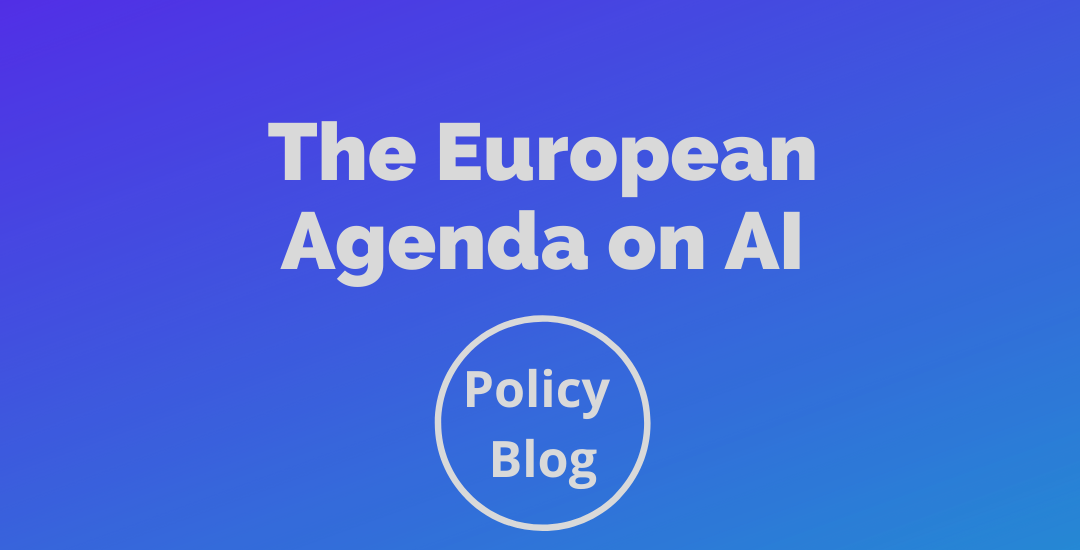- February 23, 2021
- Posted by: EARSC
- Category: Blogs

Policy blog by Aaron SCORSA and Geoff SAWYER
The European Agenda on AI: state of the art
Artificial Intelligence is one of the most strategic and horizontal instruments for innovation in many industrial activities. The European Union and all the Members States are putting a lot of effort in its standardization as wide range of different types of AI can be distinguished.
This is why AI applications are currently being implemented across a range of European industries, facing different barriers to adoption. The barriers are diverse and can be identified as endogenous on one hand with cultural resistance, lack of clear leadership, lack of knowledge and talent and financial consideration. On the other hand, as exogenous due for example to lack of venture capital funding, lack of data availability.
The European institutions are trying to face this challenge. In fact, in order to strengthen the introduction and the development of AI across the continent, all the institutions adopted their strategy. The European Commission by following the vision presented within the White Paper, the European Parliament with the work of the new special Committee on Artificial Intelligence in a Digital Age (AIDA) and the European Space Agency with projects as Φ-sat-1 and the activities of the Φ-lab.
It is the aim of the article to outline the European state of art in this horizontal domain by outlining the actions taken in support of the EO industry.
The institutional commitment on AI
The European Commission’s White Paper on AI has the purpose to launch a debate with the public, the stakeholders, the EP and the Council with the objective of reaching a political consensus. Led by DG CONNECT, the White Paper was published nearly one year ago, setting out the policy objectives with an investments-oriented approach and on how to achieve these goals. It is based on three basic principles:
- specific actions for the support, development and uptake of AI across the EU economy and public administration
- Options for a future regulatory framework on AI
- Safety and liability aspects on AI.
In the last quarter of 2020, the second European AI Alliance Assembly took place in October. This Alliance represents a forum that engaged more than 3000 citizens and stakeholders on the future of AI in Europe, late in December it was proposed an Impact Assessment.
The Commission has proved a deep involvement in increasing its funding on AI research through the Horizon 2020 programme “with EUR 1.5 billion having been pledged for the period 2018-2020 and will keep funding AI research and applications through Horizon Europe and Digital Europe programmes”[1], with the aim of continuing to support such initiative. In fact, Digital is a central tool for enabling green transition.
In the context of Earth Observation, in November 2020, the European Commission hosted a workshop on Big Data and Artificial Intelligence for Earth Observation, there were presented nine research projects on big data and artificial intelligence for Copernicus and Earth Observation, funded under the Horizon 2020 Space Programme.
According to the European Commission Agenda, the next milestones of the AI strategy will cover a legislative proposal in the first quarter of 2021 as well as an Updated Coordinated Plan.
In the European Parliament, the ITRE committee which is responsible[2] for Industrial Policy, R&D and Space Policy, has had the lead oversight on AI until the new special committee on Artificial Intelligence in Digital Age (AIDA) come into life, vested with strictly defined responsibilities[3]. Since last month of September, the European Parliament’s new special committee started officially its activities. It is important to recall that during the last debate, throughout the sessions it has been discussed about the impact AI can have on decarbonization and better use of resources from many angles. One of the highlighted activities concern the potential of adopting EO data together with AI in taking pulse of the planet[4]. Moreover, it is important to mention that the two last public hearings organized by the AIDA committee examined the impact of AI on the Green Deal and Health, whether the next two sessions will include the external policy dimension of AI and its association to competitiveness.
ESA’s commitment on AI4EO
The European Space Agency represents one of the most active actors in studying and developing artificial intelligence from different standpoints as quantum computing. In fact, from ESA’s side there is the aim of exploring the next frontiers of disruptive innovation. In fact, concerning AI and Quantum computing on EO, after the first successful launch of Φ-sat-1[5] last September, the roadmap of the next Φ-sat-2 is already undertaken.
In order to maximize benefit and competitiveness, it is important to stimulate integration of leading AI capabilities within EO Service Industry. By doing that, contracts of the next years will extend to Euro Data Cube, to Thematic Exploitation Platforms and more generally responding to the needs expressed in the conclusions of Φ-week. Further developments will come also for SAR capability developments and enhanced feature identification.
The aspiration in bridging AI with EO is manifested also with the work of the Φ-lab, which is composed by two main branches:
i. Earth Explorer Mission, where the focus is on AI on data from Copernicus and EO data
ii. Incubed Programme, providing rapid funding of innovative public private partnerships to exploit new EO markets.
These concrete examples represent the key efforts made to leverage on European companies’ capabilities and to use AI powered latest platforms technology[6].
[1] See https://cordis.europa.eu/article/id/417992-artificial-intelligence-turbocharging-european-industry
[2] ANNEX VII Powers and responsibilities of standing committees, Section IX of the Rules of Procedure of the European Parliament.
[3] The responsibilities regard: to analyze the future impact of artificial intelligence in the digital age on the EU economy, in particular on skills, employment, fintech, education, health, transport, tourism, agriculture, environment, defense.
[5] Europe’s first artificial intelligence Earth Observation mission.
[6] More information about the challenges and the possibilities are available here: https://earsc.org/2021/02/11/geoffs-blog-challenges-and-possibilities-on-bringing-eo-and-ai-together/.
